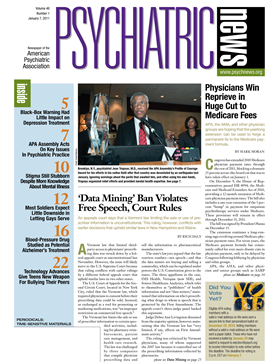More people are seeking outpatient care for their mental illness, but an increasing proportion of the treatment provided by mental health professionals consists solely of prescribed psychotropic medication and little or no psychotherapy, according to an analysis of a recent survey.
The authors of the analysis, published in the December 2010 American Journal of Psychiatry, defined psychotherapy as “a treatment technique for certain forms of mental disorders relying principally on talk/conversation between the mental health professional and the patient.” The authors decided whether patient descriptions of their mental health–related visits met this definition (which applied to individual, family, and group therapy).
The analysis included only care provided by mental health professionals, who were categorized as psychiatrists, psychologists, or social workers.
The estimated number of U.S. residents using any type of outpatient mental health care increased from 16.1 million in 1998 to 23.2 million in 2007, according to the results of the national Medical Expenditure Panel Surveys (MEPS) conducted in those years.
For both surveys, “designated informants” reported mental health care information about themselves and all of their cohabiting relatives, which included adults and children. The findings were based on nationally representative periodic and in-person surveys by the Agency for Healthcare Research and Quality of 22,953 U.S. residents in 1998 and 29,730 in 2007.
The authors found that among individuals who received any outpatient mental health care by mental health professionals, the percentage treated only with medications grew from 44 percent in 1998 to 57 percent in 2007.
Meanwhile, smaller percentages of respondents received either psychotherapy only (16 percent in 1998 and 11 percent in 2007) or psychotherapy in combination with medication (40 percent in 1998 and 22 percent in 2007).
The findings indicate possible clinical consequences for some patients, according to the authors, Mark Olfson, M.D., M.P.H., a professor in the Department of Psychiatry at Columbia University, and Steven Marcus, Ph.D., a research associate professor in the School of Social Policy and Practice at the University of Pennsylvania.
“Although the present findings raise the possibility that psychotherapy is underutilized in some clinical contexts, an assessment of the quality of care is not possible without additional information,” Olfson and Marcus wrote.
Treatment Options Declining
Benjamin Druss, M.D., M.P.H., wrote in an accompanying editorial that the findings “point to a major shift in mental health services delivery away from psychotherapy and toward psychopharmacology.” The result of that shift may be a decline in the range of treatment options available to patients.
“Many patients prefer psychotherapy as a first-line treatment, and some of the most successful trials of collaborative approaches to care improvement have given patients a choice between psychotherapy and pharmacological treatments,” Druss wrote.
He also pointed out that there are a number of likely causes for the trend away from psychotherapy, including more generous compensation to physicians for medication management compared with psychotherapy, an aggressive marketing infrastructure among pharmaceutical companies that has no counterpart for psychotherapy, and a lack of consensus among mental health professionals on the most effective types of psychotherapy for various psychiatric illnesses. Additionally, “Stigma, or a belief that these treatments are not effective, could keep patients from seeking out psychotherapy even in the face of broadened insurance coverage,” Druss wrote.
The findings indicate that both public and private health insurance providers “are still far more oriented to the delivery of medications and procedures than to cognitive and psychosocial treatments,” Druss wrote about the relative cost of multiple psychotherapy sessions compared with that of medications, many of which are available in low-cost generic formulations.
That preference by insurers led to reduced average payments for psychotherapy visits over the 10 years, which may have created “financial disincentives to providing psychotherapy,” according to the authors' analysis of the survey results. As insurance payments per psychotherapy visit declined—from $122.80 to $94.59, as did total national psychotherapy expenditures ($10.94 billion compared with $7.17 billion)—the mean number of annual psychotherapy visits per psychotherapy patient declined from 9.7 to 7.9.
Those decreases in psychotherapy use came despite a general lack of evidence that psychopharmacology alone is more efficacious and therefore more cost-effective than the use of psychotherapy alone or in combination with medications, they wrote.
More Financial Support Coming?
The trend toward the use of more psychotropics and less psychotherapy might change in the coming years, according to Druss, through the ongoing implementation of the new federal health reform and mental health parity laws. Specifically, the health care reform law enacted last March may reduce financial barriers to psychotherapy through the creation of new health insurance marketplaces and expanded Medicaid eligibility, both of which will cover some forms of mental health care.
Additionally, the insurance parity law, which went into effect for plan years beginning on or after July 1, 2010, prohibits differences in coverage between mental disorders and other medical illnesses, noted Druss. It also prohibits “nonquantitative” mechanisms, such as prior authorization and utilization review, that have long been barriers to receiving psychotherapy.
The conclusions of the analysis were limited by a variety of factors including the surveys' use of household informants, who could be unaware of some mental health care received by other household members. Additionally, the surveys were vulnerable to memory failures and omissions stemming from lingering public stigma toward psychiatric conditions.
